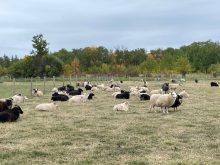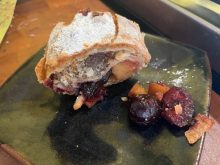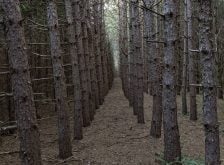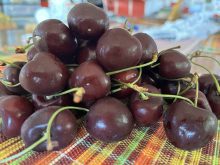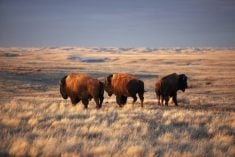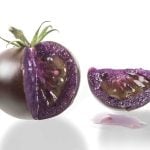Fruit growing on the Canadian Prairies is much easier and more rewarding than most people ever imagine. I am an avid fruit grower on my Alberta acreage, growing everything from plums, pears, grapes, apples and cherries to currants and raspberries. You name it, I am growing it. I am familiar with backyard Prairie gardens all the way to commercial fruit production from Ontario to Vancouver Island.
When I visited Prairie farms and Hutterite establishments, I invariably checked out the orchards, including all and any fruit-growing areas. Most individual farms had one or more poorly maintained apple or crabapple trees, the usual clump of rhubarb and always a raspberry patch. Hutterite colonies, on the other hand, in some instances had well established apple orchards, with lots of garden space given over to raspberries, strawberries, rhubarb rows and sometimes red currants. None of the farms back some 40 years or more ago had plums, pears or cherries. In many instances this has changed for the better, with significant productive fruit crop production now on farms and colonies on the Prairies.
Read Also

Gentle treatments for pain in the neck
Heading toward year-end, people unknowingly tense up against the cold and busyness, causing neck pain that can often be treated with appropriate support and gentle mobility, athletic therapist Kathlyn Hossack says.
In my almost 50 years in Prairie Canada, I gave frequent talks to urban and rural residents, primarily on fruit production, from Medicine Hat in the south to Manning in the north Peace. I gave many general gardening and fruit growing courses in rural farm areas as well as to many Hutterite colonies, even in Montana. In general, it was apparent many amateur fruit growers, Hutterites included, were poorly informed. If they grew fruits, they were old, antiquated varieties of apples, raspberries and strawberries, often very poor performers in growth and quality. Even rhubarb was harvested incorrectly. I would see rows of rhubarb in which all the leaves were removed by early June, depriving the rhubarb crowns of energy-producing leaves at the best, sunniest growing time of year. I had to explain you could remove up to 70 per cent of the rhubarb leaves but leave the outer 25 per cent to keep the crowns vigorous, healthy and productive all year.
It seemed, in general, most farm establishments clung to old ideas and old fruit varieties, often growing them in all the wrong places. Wild apples and pears all originated in northern China and Kazakhstan, in hilly, windblown areas, and plums a little further south on the Asian continent. In fact, China grows 10 times more apples than the U.S., and actually more apples than the rest of the world combined.
From Winnipeg to British Columbia’s Peace River region, I found a few successful apple orchards, with pears, plums and sour cherries growing very well. What did these orchards have in common? They were on hills, all facing northwest or north, from Lethbridge to Dawson Creek.
I had this principle explained to me by a lady in her 90s at a dairy farm near Leduc, Alta. She had a very productive orchard, with an abundance of grapes, apples, pears, plums and sour cherries. She said that on a cold January morning on the orchard hill where the house was located, the temperature could be 10 to 20 below. Where the cow barns were, way down at the south side of the hill, 100 or so metres down, the morning temperature might be -25 or -30 C or colder, sometimes 40 below. It was never this cold on the hill. During April and May, at the bottom of the hill, where she had tried growing fruit trees, the temperature could be 30 C during the day but plunging to -5 or -10 C on some nights. At the top of the hill, it was rarely more than 20 or 25 C and with a slight breeze it usually stayed above freezing in May. If you would like to confirm this information, look at our rivers that run east to west, like the North and South Saskatchewan Rivers. There are big vigorous trees on the southern banks facing north, and generally lots of scrub and few trees on the northern banks facing south.

Saved for posterity
I had many nicknames over the years in Alberta, such as Dr. Bingo (fundraising), Dr. Copper (ergot control) and Dr. Cherry (Evans cherry).
The Dr. Cherry story is an interesting one that began in 1976 at Sherwood Park. I was asked to identify a cherry tree in a home garden, with an enormous crop of cherries, estimated at 200 to 300 pounds. I could not even give it a type name since it differed widely from the only two sour cherries that grew on the Prairies: Meteor and North Star. Those cherries, bred by the University of Minnesota, did not grow that well and produced only a few pounds of cherries.
The owner of this cherry tree in Sherwood Park said the cherry came from a garden in an area called Horse Hill, which then was a hamlet between Edmonton and Fort Saskatchewan. I visited the site and found that the lady living there, a Mrs. Bogward, had a whole orchard of these cherry trees. She said the site was to be bulldozed in a month to make way for a new federal prison. Mrs. Bogward even showed me the original cherry tree her parents got in 1923. The tree was barely alive. She told me to go to the orchard and dig up many of the cherry tree suckers and save this cherry for posterity. The cherry tree grew true and very well from suckers.
This cherry’s ancestor likely originated somewhere in Siberia and was brought to Alaska by Russian immigrants. I finally found out that this hugely productive cherry probably originated from the Haines Junction research station, Yukon, on the border with Alaska, where they handed out cherry seedlings to homesteaders in the 1920s. Seedlings arrived in the Edmonton area and Mrs. Bogward’s parents received a seedling, which they planted on the homestead property.
I planted and tended around 20 of the suckers at a farm site at Tofield, Alta. In 1981 I moved to a new house in the Millwoods district in Edmonton. I found that the suckers at Tofield had multiplied considerably, and I planted some 20 of these one- to three-foot cherry trees around the Millwoods garden perimeter. By 1985 these cherry bushes were producing cherries galore and attracting city-wide attention. After many tries with various nurseries, I finally got DNA Gardens to tissue culture and multiply this cherry. No other nursery would believe that good, very productive sour cherries would overwinter in Alberta. In the meantime, I gave away hundreds of rooted cherry seedlings to Government House, the Calgary Zoo, Olds College, the Brooks research station and the University of Alberta. I virtually had to plant each cherry tree since no one would believe a real sour cherry could be winter hardy. I gave cherry trees to farmers, Hutterite colonies and commercial nurseries. By the mid 1990s there were believers, with U-pick cherry orchards springing up all over Prairie Canada from Pincher Creek to Winnipeg. This cherry, by now named the Evans cherry, numbers in many millions in both Canada and the U.S. and has become the most popular fruit tree in North America. It’s hard to find a Prairie garden outlet or big-box store on either side of the border that does not sell this cherry. Look up ‘Evans cherry’ on the internet. Look around the Prairies and you can find an abundance of cherry products, from jams and preserves to pies and wine. In suitable locations you will find productive cherry trees from Prince Albert, Sask. to Dawson Creek, B.C. and countless cherry trees in urban gardens, Prairie-wide.
In future write-ups I will deal with new apple, pear, plum, grape and cherry varieties that do very well on the Prairies, from zone 2 types to zone 4 types. Growing raspberries and strawberries will also be covered.




